We use our phones to text, take pictures, scroll through social media, and, increasingly, for shopping. With more than half of all website traffic coming from mobile devices — 52% globally and 69% in the U.S. — the “pocket computers” that my teachers said would never exist have become the new marketplace.

Clearly, I’m not immune to this shift — just ask about my (rapidly) growing collection of plants and emotional support water bottles, many purchased on mere suggestions from Facebook Collection ads. I can tell you that these purchases didn’t happen by chance — they’re an example of the growing $2.2 trillion mobile ecommerce marketplace at work.
It’s no surprise that social selling is a big player in mobile ecommerce — people trust recommendations from others, including suggestions from algorithms on platforms like Facebook.
According to the latest Meta shareholders report, 3.9 billion people use at least one of Meta’s apps each month, and collectively, we spend at least 6% more time on Facebook and Instagram due to improved algorithm-driven engagement. That makes advertising on these platforms effective for growing your business.
Of the advertising opportunities, Facebook Collection ads are especially powerful for creating immersive, engaging mobile shopping experiences to showcase your products, whether digital, physical, or service-focused. But what are Facebook Collection ads, and how can you use them to increase sales?
Table of Contents
- What is a collection on Facebook?
- How to Use Facebook Collections Ads
- How to Add to a Collection on Facebook
What is a collection on Facebook?
Facebook Collection ads are an advertising format designed to help you create an immersive shopping experience that smoothly converts shoppers into buyers.
How do Facebook collections work?
When your audience clicks on the ad, they stay on the Facebook or Instagram platforms and move into an experience that loads quickly and is streamlined for conversion.
According to Pixated Co-Founder Arham Khan, Collection ads help ecommerce clients tap into their different audience segments and strategically position their higher-ticket items.
“Collection ads are also perfect for retargeting users who have previously shown interest in higher-ticket products or services by having visited a specific web page,” says Khan.
In my experience as a shopper, I love the amount of detail I get on these immersive sales pages because it helps me decide if it’s something I want to continue learning about, am interested in buying right now, or want to move on entirely.
It’s absolutely fantastic for anyone wanting to get in front of new audiences and use the power of suggestive selling to find new buyers.
What are Facebook Collection ads?
Facebook offers three main templates for Collection ads: Instant Storefront, Instant Lookbook, and Instant Customer Acquisition. Each features a prominent video or photo at the top with three images below it. You can create your own Instant Experience, but in my experience, it’s better to start simple and then adapt from there.
Instant Storefront
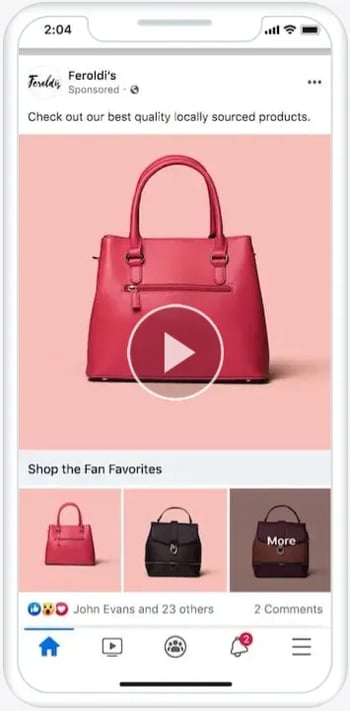
These templates are perfect for companies with at least four products with at least one main video or image and that want to drive shoppers to the website for purchase.
Instant Lookbook
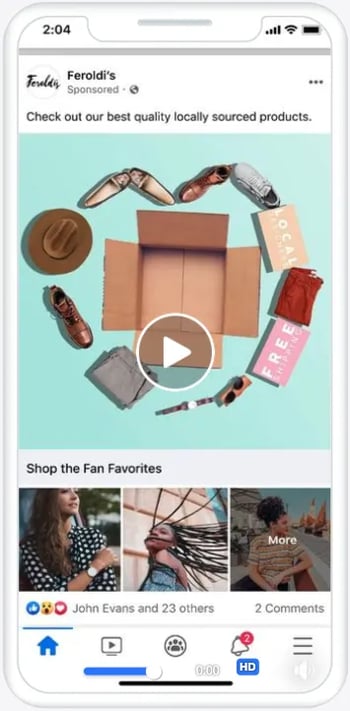
Instant Lookbooks are perfect for businesses wanting to illustrate how to use their products to highlight what life looks like with these products.
Instant Customer Acquisition
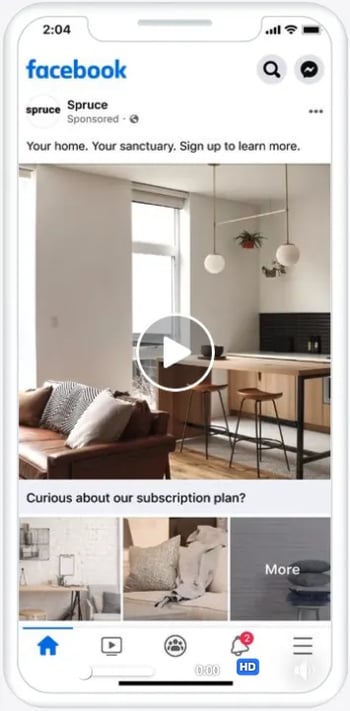
Why use Facebook Collections?
The conversion and engagement rates alone speak for themselves.
Ascendly Marketing found that Facebook Collection ads are a game-changer for mobile advertising.
“We recently ran a campaign for a client in the retail/ecommerce sector using Facebook Collection ads. Over a three-month period, the conversion rate increased from 11.21% to 15.92%, and product-specific engagement grew from 0.82% to 1.353%,” says Marshal Davis, president of Ascendly Marketing.
While the individual growth may look small by simply subtracting percentages, Ascendly’s results represent an increase in conversions and engagement of 42% and 65%, respectively.
And, while ecommerce is the most obvious industry for Facebook Collections, David Godlewski, CEO of Intelliverse, shared some astounding results for SaaS and cloud services businesses. Godlewski found Facebook Ad Collections nothing short of remarkable.
“In a recent campaign, we saw a 42% increase in the number of people clicking on our ads compared to the usual static ones. What’s more, by connecting our landing pages through these collections, we noticed a significant 25% boost in user engagement, and that translated into a solid 18% increase in users signing up for our services,” Godlewski says.
How to Use Facebook Collections Ads
A word to the wise: Before diving into creating Collections ads, make sure you have high-quality photos of the products you want to feature.
Step 1: Choose your objective & strategy.
As with any marketing campaign, it should start with strategy. Consider questions like:
- What do you want to accomplish with your ad collection?
- Do you want to generate ideas, convert buyers, or show people what the experience of buying with you can lead to?
- How and when will you evaluate metrics?
- How frequently will you rotate items? (As in retail, it’s best to keep your collection regularly updated.)
Step 2: Identify your products.
This starts with defining what experience you want to create…and, of course, what you’re selling.
In my experience, this is merchandising 101 — think about it from a brick-and-mortar perspective. If you own a boutique, you might think of what you’d put in the window to draw people in. In many ways, Facebook Collection ads are the digital equivalent.
Growth Marketer Abhi Bavishi reminds us that the items in your collection should be closely related. “Make it cohesive — they should be connected visually or thematically to create a compelling narrative.”
So to continue my boutique example, you might curate items in a single outfit, or you would put in several examples of scarves. However, you wouldn’t randomly put a scarf on a shelf next to a jacket and a pair of pants. In this same regard, curate the experience you want people to have.
Or, in the case of Perfect Locks, CEO Priyanka Swamy uses them to group and promote the different types of hair extensions, wigs, and related products they offer. She agrees on the importance of regular updates, advising people, “Take into account things like seasonal trends, types of products, and customer preference as you update your collections.”
Step 3: Pull together details.
This will make creating your catalog a seamless process. Here’s what you’ll need to collect:
- Product Name
- Product Description, ideally including details like color, size, and price, where applicable
- Product Links
- High-Quality Product Images that are at least 500px x 500px
Step 4: Create a catalog in Commerce Manager.
Meta recommends creating a catalog in Commerce Manager before you dive into Collection ads. In my experience, not every type of Collection ad draws from the catalog.
However, by developing it, you have a solid starting point (and all of the information you’ll need) when it’s time to create your ad and the Instant Experience. With that in mind, I’m showing you how to create the catalog here.
Ultimately, a catalog is simply a list of all of your products. Meta recommends using a single catalog for everything you plan to sell. Once you have a catalog, you can manage your items, set up a shop, or create any number of ad campaigns, including:
- Meta Advantage+ catalog ads (formerly dynamic ads).
- Collection ads.
- Carousel ads.
- Collaborative ads and more.
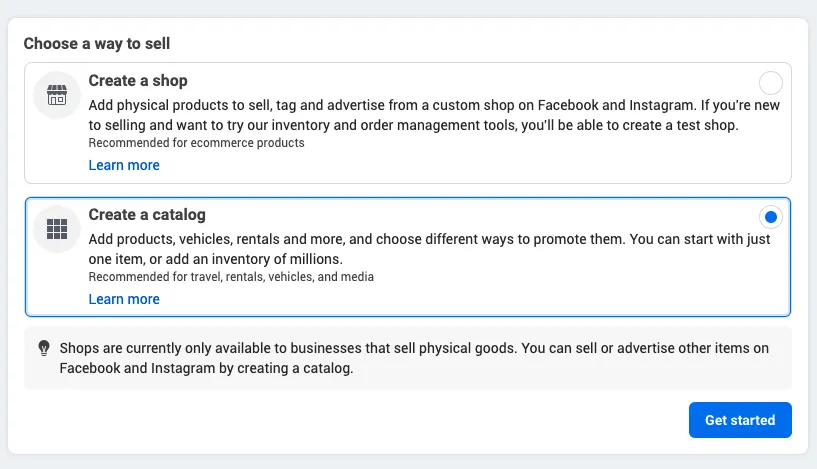
Creating a catalog is as simple as going into Commerce Manager, choosing Create a catalog, and getting started.
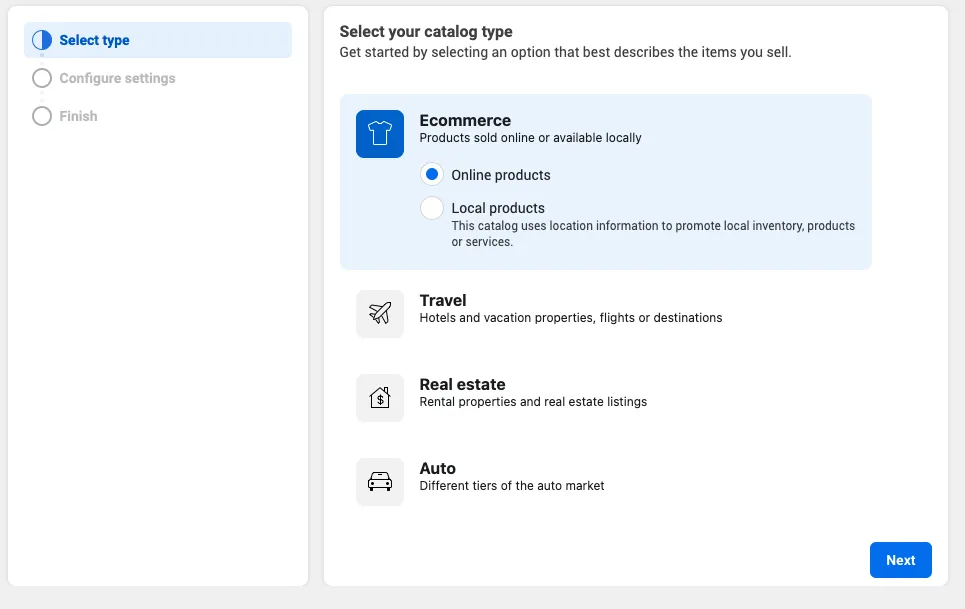
You’ll be able to choose between Ecommerce, Travel, Real Estate, or Auto. Within each of those main categories, you’ll be able to narrow things down further.
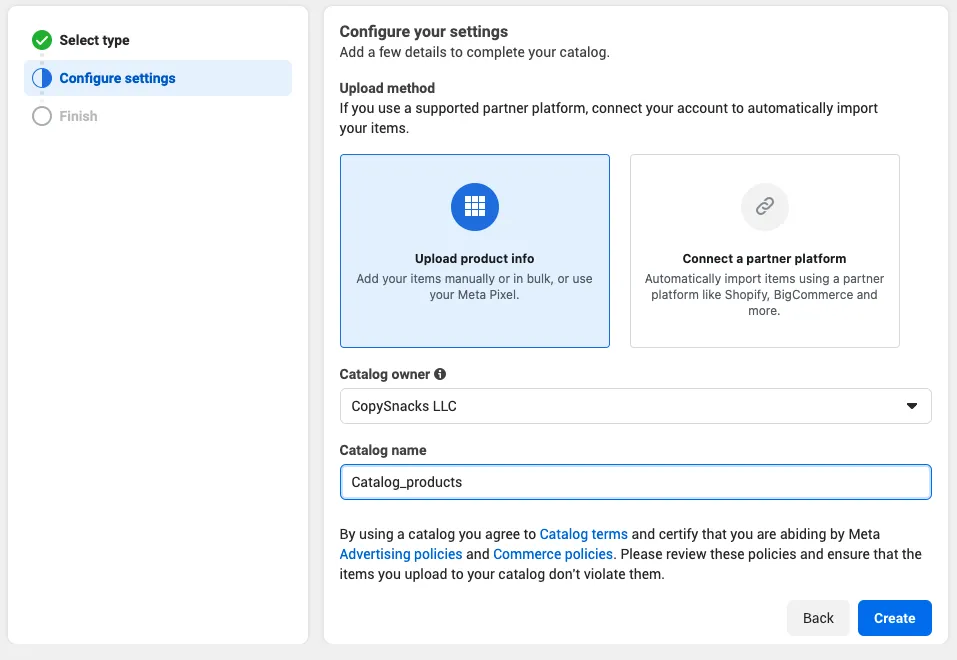
Next, you’ll configure your settings before being taken back to Commerce Manager where you can add items by following the cues.
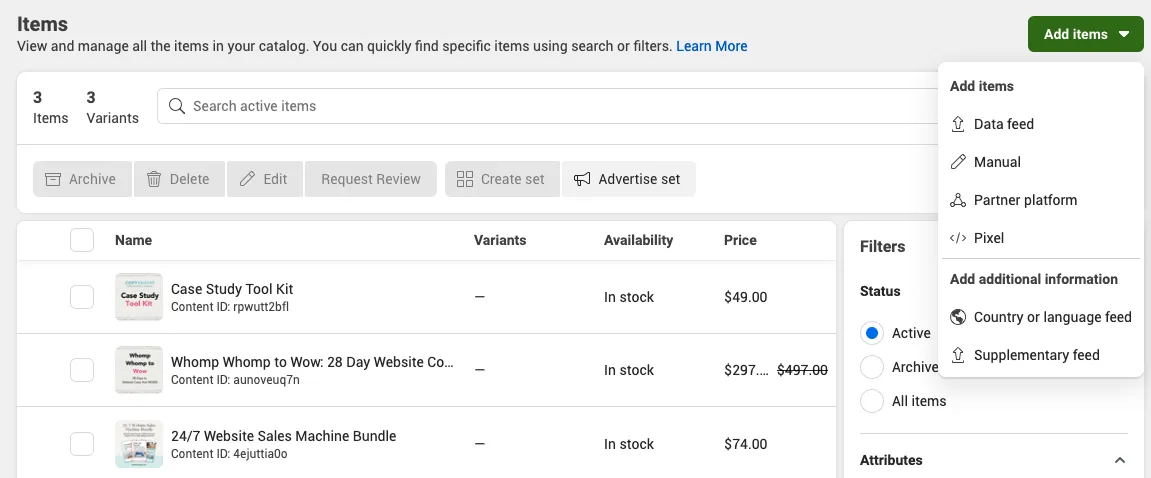
Once your products are loaded, you’ll need to go back to Ads Manager.
How to Add to a Collection on Facebook
Now that your products are ready and loaded into your Facebook catalog, it’s time to create your Facebook Collection ad.

Start by clicking on the green Create button.
Step 1: Choose an objective.
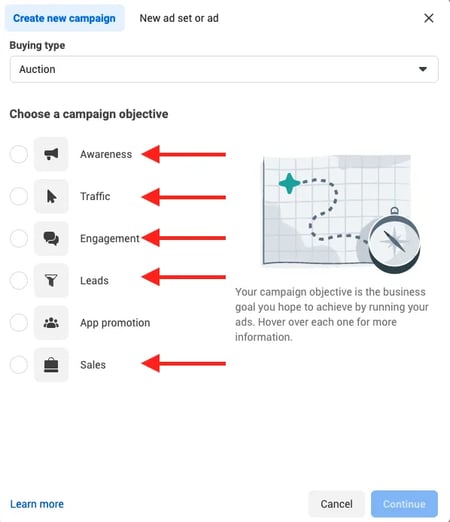
The following objectives will work for Collection ads:
- Awareness.
- Traffic.
- Engagement.
- Sales.
- Leads.

If you need help choosing, you can select an item, and Meta will give you some hints. After selecting Continue, Meta may offer some hints based on past ad performance. For the purposes of this, I recommend proceeding with Manual setup to ensure your first collection goes off without a hitch.
Step 2: Provide campaign details.

Define campaign details, whether you want to do an A/B test and any Advantage campaign budget information, and click Next. If you’re not familiar with any of these, or are just hoping to test Collections and see how they work, I’d recommend leaving A/B test blank. You can always optimize later.
Step 3: Define conversions & ad details.
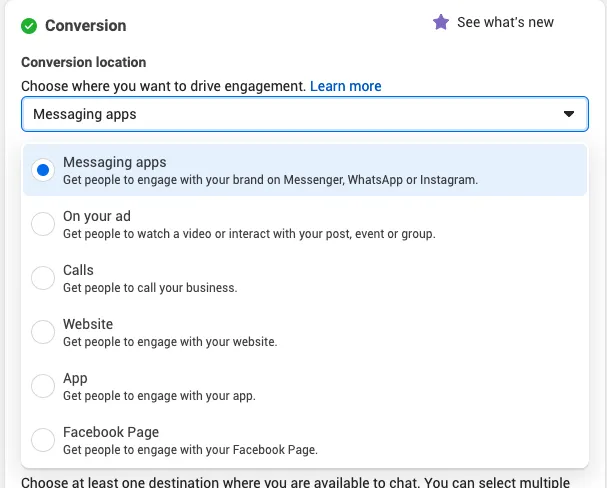
Select either Website or App for your conversion location — if you have an app, Meta recommends selecting that option.
From there, set your budget, audience, placements, and optimization, then click Next.
Step 4: Set identity.
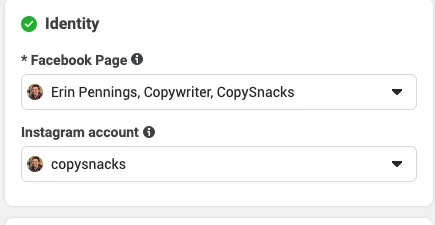
Choose your Facebook and Instagram accounts. Meta may have already auto-selected them, but confirm they are correct.
Step 5: Set up your ads.
To set up your ad, choose Catalog as the creative source. Then select Collection as the format.
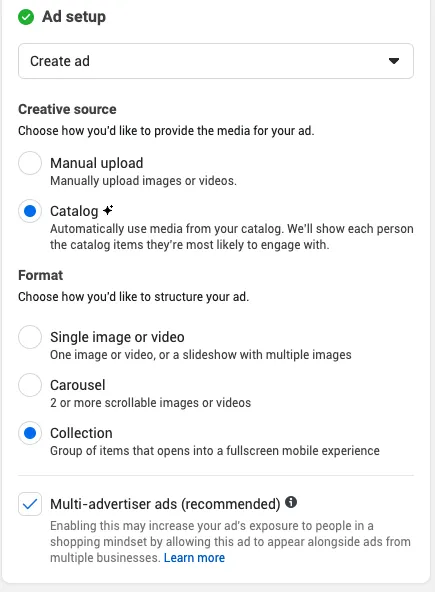
Under Ad Creative, you’ll be asked to include a short headline related to your ad.

Choose Create new to select a template.

Although you can create a custom Instant Experience, I’d recommend starting with one of the built-in options until you gain familiarity with Collection ads. Once you select one, click Next.
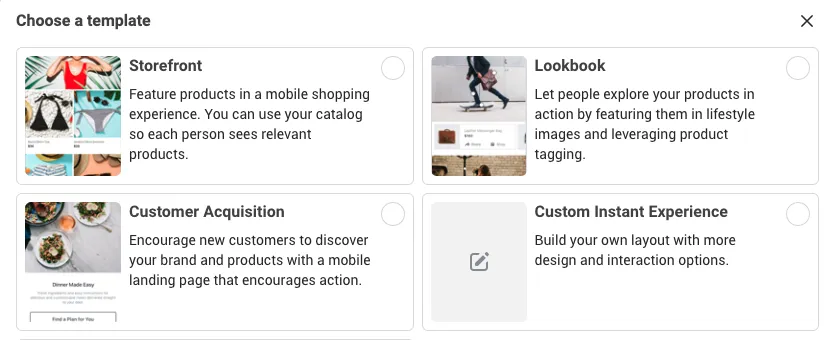
Step 6: Set up your instant experience.
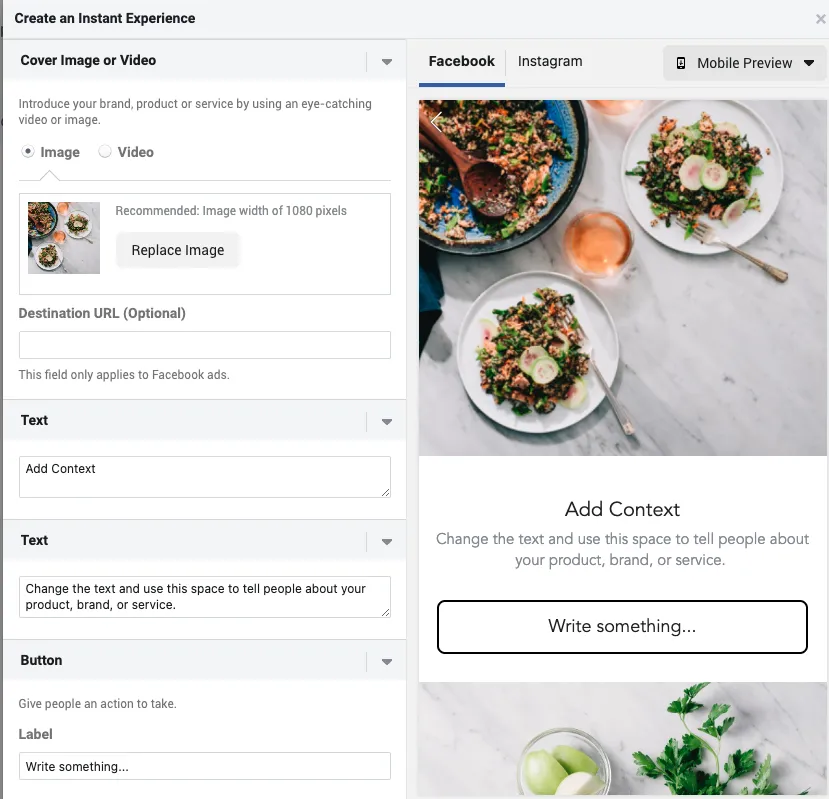
Now it’s just a matter of replacing your content with Meta’s content. Depending on the type of collection, you may need to add your catalog back in. If that’s the case, just make sure you have your images and descriptions ready to go!
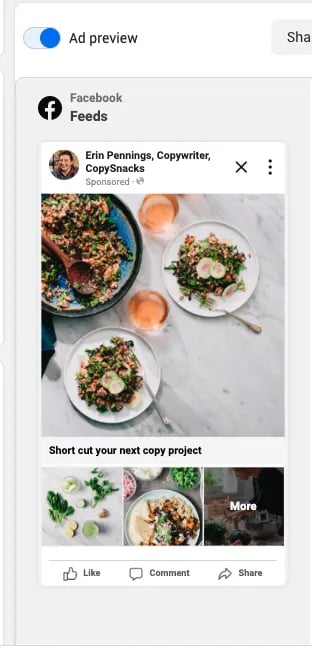
Once you click Done, you can toggle the ad preview switch to “on” to see what your ad will look like.
Step 7: Publish your ad.

Now that your ad is set up and ready to go, all that’s left is to hit Publish.
Once someone interacts with your ad and taps on it, they’ll get access to your Instant Experience.
Step 8: Optimize your ad.
As the results start to come in, it’s time to optimize your ad. That may mean using A/B test elements to see what performs best — you can test anything from headlines, offers, copy, images, and videos.
And, don’t forget to retarget. As Khan from Pixated reminds us, “Even though I see stellar conversion rates from Collection ads, the majority of users still won’t be clicking through. But you can specifically retarget these individuals by creating custom audiences and reminding them of why they were checking out your product or service in the first place.”
Want to learn more about making the most of Facebook and Instagram advertising? Grab our Beginner’s Guide to Facebook & Instagram.
Facebook Collections are a digital storefront.
Ultimately, Facebook Collections and their instant experiences are the next step around creating an omnichannel experience for online shoppers. By thinking of this ad strategy as the digital equivalent of a brick-and-mortar storefront, it will be far easier to define and curate the experience.
Editor's note: This article was originally published in October 2012 and has been updated for comprehensiveness.

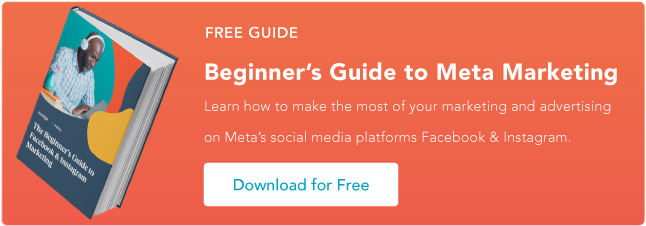









![How to Use Pinterest to Promote Your Business or Blog [Free Templates]](https://blog.hubspot.com/hubfs/Pinterest%20for%20Marketing.jpg)